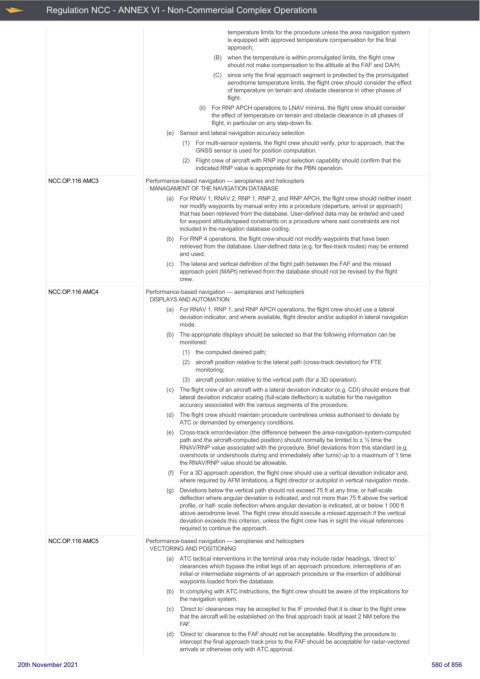Page 580 - UK Air Operations Regulations 201121
P. 580
~
~ Regulation NCC - ANNEX VI - Non-Commercial Complex Operations Centrik
temperature limits for the procedure unless the area navigation system
is equipped with approved temperature compensation for the final
approach;
(B) when the temperature is within promulgated limits, the flight crew
should not make compensation to the altitude at the FAF and DA/H;
(C) since only the final approach segment is protected by the promulgated
aerodrome temperature limits, the flight crew should consider the effect
of temperature on terrain and obstacle clearance in other phases of
flight.
(ii) For RNP APCH operations to LNAV minima, the flight crew should consider
the effect of temperature on terrain and obstacle clearance in all phases of
flight, in particular on any step-down fix.
(e) Sensor and lateral navigation accuracy selection
(1) For multi-sensor systems, the flight crew should verify, prior to approach, that the
GNSS sensor is used for position computation.
(2) Flight crew of aircraft with RNP input selection capability should confirm that the
indicated RNP value is appropriate for the PBN operation.
NCC.OP.116 AMC3 Performance-based navigation — aeroplanes and helicopters
MANAGAMENT OF THE NAVIGATION DATABASE
(a) For RNAV 1, RNAV 2, RNP 1, RNP 2, and RNP APCH, the flight crew should neither insert
nor modify waypoints by manual entry into a procedure (departure, arrival or approach)
that has been retrieved from the database. User-defined data may be entered and used
for waypoint altitude/speed constraints on a procedure where said constraints are not
included in the navigation database coding.
(b) For RNP 4 operations, the flight crew should not modify waypoints that have been
retrieved from the database. User-defined data (e.g. for flex-track routes) may be entered
and used.
(c) The lateral and vertical definition of the flight path between the FAF and the missed
approach point (MAPt) retrieved from the database should not be revised by the flight
crew.
NCC.OP.116 AMC4 Performance-based navigation — aeroplanes and helicopters
DISPLAYS AND AUTOMATION
(a) For RNAV 1, RNP 1, and RNP APCH operations, the flight crew should use a lateral
deviation indicator, and where available, flight director and/or autopilot in lateral navigation
mode.
(b) The appropriate displays should be selected so that the following information can be
monitored:
(1) the computed desired path;
(2) aircraft position relative to the lateral path (cross-track deviation) for FTE
monitoring;
(3) aircraft position relative to the vertical path (for a 3D operation).
(c) The flight crew of an aircraft with a lateral deviation indicator (e.g. CDI) should ensure that
lateral deviation indicator scaling (full-scale deflection) is suitable for the navigation
accuracy associated with the various segments of the procedure.
(d) The flight crew should maintain procedure centrelines unless authorised to deviate by
ATC or demanded by emergency conditions.
(e) Cross-track error/deviation (the difference between the area-navigation-system-computed
path and the aircraft-computed position) should normally be limited to ± ½ time the
RNAV/RNP value associated with the procedure. Brief deviations from this standard (e.g.
overshoots or undershoots during and immediately after turns) up to a maximum of 1 time
the RNAV/RNP value should be allowable.
the RNAV/RNP value should be allowable.
(f) For a 3D approach operation, the flight crew should use a vertical deviation indicator and,
where required by AFM limitations, a flight director or autopilot in vertical navigation mode.
(g) Deviations below the vertical path should not exceed 75 ft at any time, or half-scale
deflection where angular deviation is indicated, and not more than 75 ft above the vertical
profile, or half- scale deflection where angular deviation is indicated, at or below 1 000 ft
above aerodrome level. The flight crew should execute a missed approach if the vertical
deviation exceeds this criterion, unless the flight crew has in sight the visual references
required to continue the approach.
NCC.OP.116 AMC5 Performance-based navigation — aeroplanes and helicopters
VECTORING AND POSITIONING
(a) ATC tactical interventions in the terminal area may include radar headings, ‘direct to’
clearances which bypass the initial legs of an approach procedure, interceptions of an
initial or intermediate segments of an approach procedure or the insertion of additional
waypoints loaded from the database.
(b) In complying with ATC instructions, the flight crew should be aware of the implications for
the navigation system.
(c) ‘Direct to’ clearances may be accepted to the IF provided that it is clear to the flight crew
that the aircraft will be established on the final approach track at least 2 NM before the
F A F .
(d) ‘Direct to’ clearance to the FAF should not be acceptable. Modifying the procedure to
intercept the final approach track prior to the FAF should be acceptable for radar-vectored
arrivals or otherwise only with ATC approval.
20th November 2021 580 of 856

